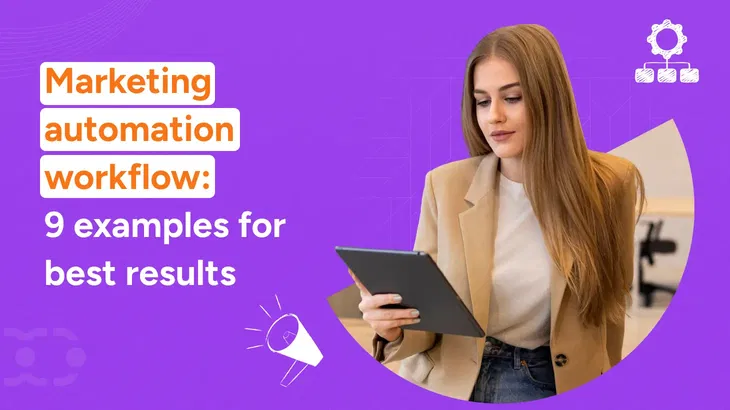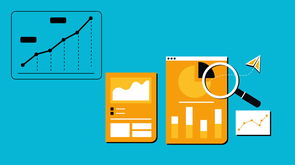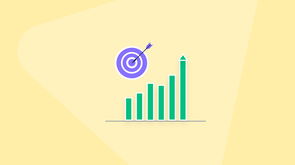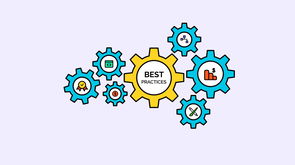-> Triggers
These are the specific events or actions that initiate the automated workflow, such as a customer signing up for a newsletter or making a purchase.
-> Conditional logic
These are the specific rules that determine the subsequent steps in the workflow based on user behavior or predefined criteria, ensuring personalized and relevant interactions.
-> Automated actions
There are tasks executed automatically in response to triggers and conditions, including sending emails, updating contact information, or assigning leads to sales reps.
-> Delays or timers
The scheduled intervals that space out actions within the workflow ensure follow-up communications are consistently driven and not so overwhelming to the recipients.
-> Audience segmentation
Divide the audience through multiple segmentation groups that are based on specific criteria. It results in more targeted and personalized customer experiences.
Why does your business need the marketing automation workflow?
Marketing workflow automation is essential for modern businesses to streamline operations, enhance efficiency, and drive better growth. Here is why it is crucial:
- Time efficiency
Automating the repetitive tasks such as email campaigns and social media posts keeps the teams free to focus on strategy and creativity.
- Unified brand messaging
It ensures consistent communication across all social media channels to keep strengthening trust and brand recognition.
- Scalable personalization
Tailored marketing campaigns for segmented customers based on demographics, purchase history, or based on customer engagement levels.
- Improved customer journey mapping
Mapping a customer journey that systematically ensures that they receive relevant offers or information at the right time improves the overall customer experience.
- Scalable business
Marketing workflow automation with a CRM tool can help grow business and can help in handling multiple customers without any additional manual efforts or resources.
Nine simple & actionable marketing workflow automation examples
In this section, we will begin with the list of marketing automation workflow examples:
1) Workflow for adding new email leads
An effective welcome email sequence is crucial for engaging new leads and guiding them towards their first purchase.
A well-structured email marketing automation workflow can easily enhance user experience and conversion rates. Let’s learn the same through an example of a successful welcome email workflow:
Case study: X company three-step email marketing campaign
X, an online retailer, implemented a targeted three-step email sequence to nurture new subscribers:
- Initial engagement: The new subscriber needs to purchase within one week of registering then X will send an email encouraging them to save their preferred search filters, through a medium of personalized communication.
- Feature introduction: A few days later, a follow-up email that highlighted the variety of brands available on the site and guided users on how to mark favorites, enhancing user engagement with an automation platform.
- Incentive offering: The final email provided details on marketing strategies, such as combining orders and offering tangible value to the subscribers.
2) Workflows for recovering abandoned carts
Marketing workflow automation for recovering abandoned carts is essential for eCommerce businesses aiming to recapture lost sales and enhance the business revenue:
a) Identification of cart abandonment
Utilize tracking tools to detect when customers add items to their cart but leave the site without completing the purchase.
b) Automated follow-up sequence
- Email reminders: Send personalized emails reminding the customer of their abandoned carts.
- SMS notifications: Complement emails with SMS messages to increase re-engagement chances.
- Web push notifications: Employ push notifications to remind customers of their pending purchases.
c) Personalization and incentives
Customize messages to include the customer's name, specific items left in the cart, and tailored incentives like discounts or free shipping to encourage completion of the purchase.
d) Multi-channel approach
To ensure consistent and effective communication, engage customers across various platforms, including email, SMS, and social media.
3) Workflows for inventory alerts
The inventory alert workflows are essential for eCommerce businesses to boost customer conversions. Here's how such workflows operate:
1) Trigger identification: Set up triggers for specific events, such as:
- Back-in-stock alerts: Notify users when previously viewed or out-of-stock items become available.
- Price drop notifications: Inform users when items they've shown interest in are discounted.
Here are some of the best practices:
- Craft tailored messages via email, push notifications, SMS, or WhatsApp, highlighting the specific products and offers relevant to each user.
- Deliver alerts across preferred channels to maximize reach and engagement.
- Analyze engagement metrics to assess the effectiveness of the alerts and refine strategies accordingly.
4) Workflows for sending targeted price drops
The inventory marketing workflows are essential for eCommerce businesses to engage customers effectively and boost conversions. Here's how such workflows operate:
- Utilize platforms like Insider to automatically gather user data, including browsing history, preferences, and behaviors.
-> Set up triggers for every event, such as back-in-stock or re-purchases.
- Deliver alerts across preferred channels to maximize reach and engagement.
- Analyze engagement metrics to assess the effectiveness of the alerts and refine strategies accordingly.
5) Confirming purchases or orders emails
The order confirmation workflows enhance customer experience and build trust in your eCommerce operations. Here is how you can structure these workflows across multiple channels:
- Purchase event: The workflow is initiated immediately after a customer completes a purchase.
- Email confirmation: Send a detailed order confirmation email including the order number, item details, billing and shipping information, and payment summary. This digital receipt reassures the customer that their order has been received.
- SMS notification: Dispatch a concise SMS acknowledging the order, which is particularly effective for customers who prefer mobile communication.
- Whatsapp message: Utilize platforms like Salesmate to send personalized order confirmations via Whatsapp, leveraging its high email open rates to ensure prompt customer engagement.
- Cross-selling opportunities: Including the recommendations for related products to encourage additional purchases.
- Feedback request: Invite customers to share their shopping experience to gather valuable insights.
- Customer journey builder: Set up marketing workflow management software is using to streamline the process and ensure timely communications.
6) For the upsells and cross sells
The automation workflows in upselling and cross selling can help as follows:
- Segmentation: Divide your customer base into segments based on behavior, preferences, and purchase history to deliver more personalized content and effective upsell and cross-sell offers.
- A/B Testing: Experiment with different offers, messaging, and timing to determine what resonates best with each customer segment, optimizing the effectiveness of your email campaigns.
- Monitor performance: Regularly analyze key metrics such as conversion rates and customer feedback to assess the success of your automated workflows and make adjustments as needed.
7) Let your customers get the newsletter
A well-structured email newsletter strategy is essential for maintaining consistent customer engagement.
Brands like Goop exemplify this by sending 12 mobile-optimized emails monthly, keeping their audience informed and connected.
Benefits of regular email newsletters:
- Enhanced customer engagement: Regular newsletters inform your audience about your brand's latest updates, products, and services, fostering a stronger connection.
- Increased website traffic: Sharing valuable content encourages subscribers to visit your website, boosting traffic and potential conversions.
- Improved brand awareness: Consistent communication helps reinforce the overall brand's presence in the minds of consumers.
Implementing the marketing automation for newsletters.
Marketing automation software can also help you create AI design workflows to streamline the process of sending curated newsletters, allowing you to focus on content strategy while ensuring timely delivery.
8) Target through a multi-channel marketing program
A multi-channel marketing program integrates various communication channels such as email, text messages, social ads, and apps to engage users seamlessly, ensuring maximum reach and enhanced customer satisfaction:
1) Registration and welcome stage
Trigger: User registers for the program (e.g., Starbucks rewards).
Action: Send a welcome email with details about the program and its benefits.
Encourage users to opt-in for text notifications and download the app for a more personalized experience.
2) Data collection and segmentation
Trigger: User activity, such as app usage, website interactions, or purchases.
Action: Collect data on preferences, purchase history, and engagement across channels.
Segment users into categories (e.g., frequent buyers, deal seekers, and more).
3) Multi-channel engagement
Email: Provide detailed information about rewards, promotions, or personalized recommendations.
Example: A monthly summary of points earned and upcoming offers.
SMS/Text messages: Send time-sensitive alerts or updates.
Example: "Flash Sale! Earn double rewards points today only."
Push Notifications (app): Deliver location-based offers or reminders.
Example: "Your favorite drink is waiting! Order now for 20% off."
Social media ads: Retarget users who interacted with your brand but didn't complete a purchase.
Example: Ads showing items left in their cart or tailored promotions.
4) Omnichannel personalization
Ensure consistent messaging across all channels, maintaining a unified tone and design.
Use personalization techniques, such as addressing users by name or referencing past purchases.
5) Reward and retain
Trigger: User achieves a milestone (e.g., 10 purchases) or has a special event (e.g., birthday).
Action: Send a reward email or push notification highlighting their accomplishment.
Offer exclusive discounts or free items to celebrate the event and encourage further engagement.
6) Feedback and optimization
Trigger: Post-purchase or after milestone achievements.
Action: Use email or SMS to collect user experience feedback.
Analyze engagement metrics across channels to identify which tactics drive the best results.
9) Boost revenues with re-purchase programs
Repurchase programs are a powerful marketing strategy designed to engage customers post-purchase, gather feedback, and drive repeat selling opportunities:
1) Gather customer feedback post-purchase
- Trigger: After a customer makes a purchase, send an email or SMS to request feedback on their experience and product satisfaction.
- Example: Chewy's feedback email asking customers about their recent purchase with better customer retention rates.
- Why it matters: Feedback helps understand customer preferences, identify pain points, and tailor future recommendations.
2) Creates a data-driven personalized campaigns
Use the feedback collected to segment email automation workflows for customers based on their responses:
- Satisfied customers: Offer complementary products (cross-sell) or premium versions of the purchased item.
- Neutral/dissatisfied customers: Address concerns and provide tailored offers to enhance their experience.
3) Timely emails
Automate follow-up emails or notifications at strategic intervals throughout the customer's lifecycle:
- Replenishment reminder: Send reminders when the product is likely to run low on consumable goods (e.g., pet food, or skincare).
- Seasonal or occasion-based offers: Send personalized recommendations during key moments like holidays or anniversaries.
4) Social media engagement
- Email campaigns: Send personalized product recommendations based on the initial purchase.
- Example: "Loved your last purchase? Check out these perfect pairings."
- SMS or push notifications: Use short, engaging messages for timely offers.
- Example: "Your favorite product is back in stock with a special discount!"
- Social media retargeting: Show ads featuring related or complementary products to previous buyers.
5) Automate and optimize the process
Implement a marketing automation platform for customer relationships:
- Automated campaigns for feedback collection after purchases.
- Segment users and create customer data-tailored cross-sell or up-sell campaigns.
- Track and analyze campaign performance to refine strategies for relevant content.
Wrap up!
The digital landscape of today's world is not limited, to acquiring customers but requires a process that includes nurturing leads to meaningful personalized interactions that helps in unlocking customer retention and better revenue.
You can drive sales through abandoned cart recovery, upselling or cross-selling, newsletters, or repurchase programs, in all ways businesses are trying to build deeper customer relationships while driving better results.
Now it's your turn:
- Which marketing automation workflow resonates the most with your business needs?
- Are you leveraging all the channels available to engage your customers effectively?
Let's brainstorm together!
Even with all the necessary tactics it is crucial to engage better customers and drive the sales growth for your businesses to create your own marketing workflow automation.







Key Takeaways
The marketing world is consistently evolving to give the best leads for boosting sales revenue.
Nowadays, social media platforms like LinkedIn can help you connect with billions of users worldwide by leveraging engagement, building brand presence, and driving better business growth.
That's why marketing is a crucial part of every business, from small to enterprise level. Let's understand the importance through different stats:
Such numbers highlight that marketing is no longer a luxury but a necessity for every business. Yet, with endless channels and tactics to manage, staying ahead feels impossible.
Then enters marketing automation, your secret weapon for staying organized, relevant, and impactful. This blog will help you understand the marketing automation workflow and its examples.
What is a marketing automation workflow?
Marketing workflow automation is the structured sequence of automated actions designed to execute marketing tasks efficiently and effectively.
These workflows use technology to streamline repetitive tasks, such as sending emails, onboarding new users, or nurturing leads based on predefined triggers and conditions.
Following a step-by-step process ensures consistent communication and engagement with potential or existing customers throughout their journey.
For example, basic marketing workflow automation for onboarding a new user:
What does marketing automation process flow contain?
A marketing automation workflow contains several key components that work together to streamline and enhance marketing efforts:
-> Triggers
These are the specific events or actions that initiate the automated workflow, such as a customer signing up for a newsletter or making a purchase.
-> Conditional logic
These are the specific rules that determine the subsequent steps in the workflow based on user behavior or predefined criteria, ensuring personalized and relevant interactions.
-> Automated actions
There are tasks executed automatically in response to triggers and conditions, including sending emails, updating contact information, or assigning leads to sales reps.
-> Delays or timers
The scheduled intervals that space out actions within the workflow ensure follow-up communications are consistently driven and not so overwhelming to the recipients.
-> Audience segmentation
Divide the audience through multiple segmentation groups that are based on specific criteria. It results in more targeted and personalized customer experiences.
Why does your business need the marketing automation workflow?
Marketing workflow automation is essential for modern businesses to streamline operations, enhance efficiency, and drive better growth. Here is why it is crucial:
- Time efficiency
Automating the repetitive tasks such as email campaigns and social media posts keeps the teams free to focus on strategy and creativity.
- Unified brand messaging
It ensures consistent communication across all social media channels to keep strengthening trust and brand recognition.
- Scalable personalization
Tailored marketing campaigns for segmented customers based on demographics, purchase history, or based on customer engagement levels.
- Improved customer journey mapping
Mapping a customer journey that systematically ensures that they receive relevant offers or information at the right time improves the overall customer experience.
- Scalable business
Marketing workflow automation with a CRM tool can help grow business and can help in handling multiple customers without any additional manual efforts or resources.
Nine simple & actionable marketing workflow automation examples
In this section, we will begin with the list of marketing automation workflow examples:
1) Workflow for adding new email leads
An effective welcome email sequence is crucial for engaging new leads and guiding them towards their first purchase.
A well-structured email marketing automation workflow can easily enhance user experience and conversion rates. Let’s learn the same through an example of a successful welcome email workflow:
Case study: X company three-step email marketing campaign
X, an online retailer, implemented a targeted three-step email sequence to nurture new subscribers:
2) Workflows for recovering abandoned carts
Marketing workflow automation for recovering abandoned carts is essential for eCommerce businesses aiming to recapture lost sales and enhance the business revenue:
a) Identification of cart abandonment
Utilize tracking tools to detect when customers add items to their cart but leave the site without completing the purchase.
b) Automated follow-up sequence
c) Personalization and incentives
Customize messages to include the customer's name, specific items left in the cart, and tailored incentives like discounts or free shipping to encourage completion of the purchase.
d) Multi-channel approach
To ensure consistent and effective communication, engage customers across various platforms, including email, SMS, and social media.
3) Workflows for inventory alerts
The inventory alert workflows are essential for eCommerce businesses to boost customer conversions. Here's how such workflows operate:
1) Trigger identification: Set up triggers for specific events, such as:
Here are some of the best practices:
4) Workflows for sending targeted price drops
The inventory marketing workflows are essential for eCommerce businesses to engage customers effectively and boost conversions. Here's how such workflows operate:
-> Set up triggers for every event, such as back-in-stock or re-purchases.
5) Confirming purchases or orders emails
The order confirmation workflows enhance customer experience and build trust in your eCommerce operations. Here is how you can structure these workflows across multiple channels:
6) For the upsells and cross sells
The automation workflows in upselling and cross selling can help as follows:
7) Let your customers get the newsletter
A well-structured email newsletter strategy is essential for maintaining consistent customer engagement.
Brands like Goop exemplify this by sending 12 mobile-optimized emails monthly, keeping their audience informed and connected.
Benefits of regular email newsletters:
Implementing the marketing automation for newsletters.
Marketing automation software can also help you create AI design workflows to streamline the process of sending curated newsletters, allowing you to focus on content strategy while ensuring timely delivery.
8) Target through a multi-channel marketing program
A multi-channel marketing program integrates various communication channels such as email, text messages, social ads, and apps to engage users seamlessly, ensuring maximum reach and enhanced customer satisfaction:
1) Registration and welcome stage
Trigger: User registers for the program (e.g., Starbucks rewards).
Action: Send a welcome email with details about the program and its benefits.
Encourage users to opt-in for text notifications and download the app for a more personalized experience.
2) Data collection and segmentation
Trigger: User activity, such as app usage, website interactions, or purchases.
Action: Collect data on preferences, purchase history, and engagement across channels.
Segment users into categories (e.g., frequent buyers, deal seekers, and more).
3) Multi-channel engagement
Email: Provide detailed information about rewards, promotions, or personalized recommendations.
Example: A monthly summary of points earned and upcoming offers.
SMS/Text messages: Send time-sensitive alerts or updates.
Example: "Flash Sale! Earn double rewards points today only."
Push Notifications (app): Deliver location-based offers or reminders.
Example: "Your favorite drink is waiting! Order now for 20% off."
Social media ads: Retarget users who interacted with your brand but didn't complete a purchase.
Example: Ads showing items left in their cart or tailored promotions.
4) Omnichannel personalization
Ensure consistent messaging across all channels, maintaining a unified tone and design.
Use personalization techniques, such as addressing users by name or referencing past purchases.
5) Reward and retain
Trigger: User achieves a milestone (e.g., 10 purchases) or has a special event (e.g., birthday).
Action: Send a reward email or push notification highlighting their accomplishment.
Offer exclusive discounts or free items to celebrate the event and encourage further engagement.
6) Feedback and optimization
Trigger: Post-purchase or after milestone achievements.
Action: Use email or SMS to collect user experience feedback.
Analyze engagement metrics across channels to identify which tactics drive the best results.
9) Boost revenues with re-purchase programs
Repurchase programs are a powerful marketing strategy designed to engage customers post-purchase, gather feedback, and drive repeat selling opportunities:
1) Gather customer feedback post-purchase
2) Creates a data-driven personalized campaigns
Use the feedback collected to segment email automation workflows for customers based on their responses:
3) Timely emails
Automate follow-up emails or notifications at strategic intervals throughout the customer's lifecycle:
4) Social media engagement
5) Automate and optimize the process
Implement a marketing automation platform for customer relationships:
Salesmate – A game changing marketing workflow management software for businesses
Salesmate is one of those game-changing marketing automation tools that can help your marketing team stay ahead to get more leads:
Build and customize your own marketing automation workflow!
Salesmate can help in making your marketing workflow automation that creates a system for your business.
Wrap up!
The digital landscape of today's world is not limited, to acquiring customers but requires a process that includes nurturing leads to meaningful personalized interactions that helps in unlocking customer retention and better revenue.
You can drive sales through abandoned cart recovery, upselling or cross-selling, newsletters, or repurchase programs, in all ways businesses are trying to build deeper customer relationships while driving better results.
Now it's your turn:
Let's brainstorm together!
Even with all the necessary tactics it is crucial to engage better customers and drive the sales growth for your businesses to create your own marketing workflow automation.
Frequently asked questions!
1) How can marketing automation workflows benefit your business?
Implementing marketing workflows can significantly enhance your business with repetitive tasks by improving lead nurturing and overall efficiency.
By automating processes such as email campaigns, social media postings, and customer segmentation, your marketing team can focus on strategic initiatives that drive better growth.
2) What are common challenges in implementing marketing automation workflows?
Implementing the marketing automation workflow can present several challenges for the businesses that need to be addressed, and they are:
3) Can small businesses afford marketing automation?
Yes, small businesses can afford marketing automation. Many platforms tend to offer scalable solutions tailored to fit various budgets; marketing automation is accessible even to smaller enterprises.
That's why by investing in marketing automation, marketing businesses can streamline their marketing efforts, improve customer engagement, and achieve a higher return on investment while operating within their financial means.
4) How can one measure the success of a marketing automation workflow?
There are different KPIs to measure workflow for marketing automation, including:
Regularly assessing the KPIs enables continuous optimization of your marketing strategies, ensuring they align with business objectives and deliver tangible results.
5) How long does setting up a marketing automation workflow take?
The time required to set up a marketing automation workflow varies based on complexity and the tools employed. The setup can be completed within a few hours for an aligned workflow, such as a welcome email newsletter subscription.
In contrast, more intricate workflows allow multiple triggers, conditions, and personalized actions for several days to weeks for thorough planning, configuration, and testing.
Juhi Desai
Content WriterJuhi is a passionate writer and reader. She is working with the team of content creators at Salesmate. Always seeking to learn something new, Juhi has an optimistic approach towards life. When she is not writing you can find her with a book and a coffee by her side.